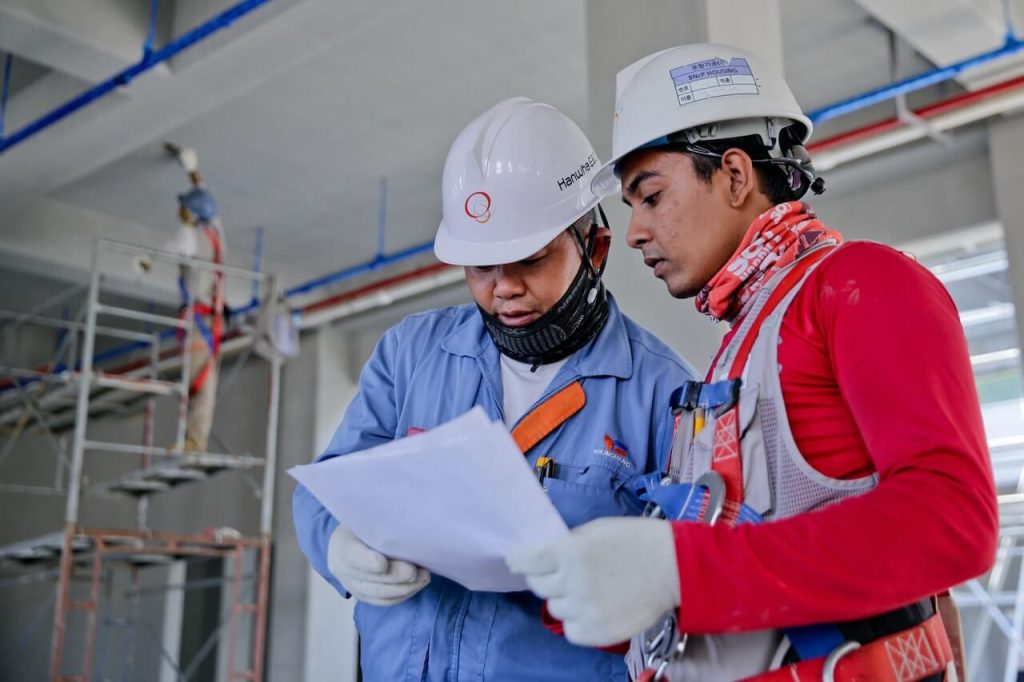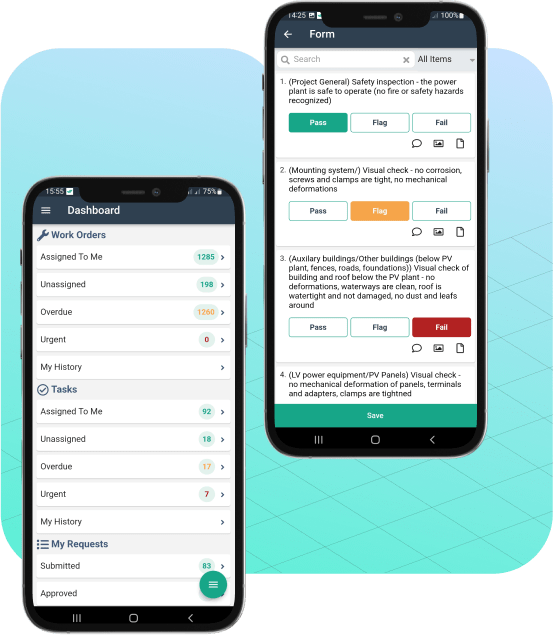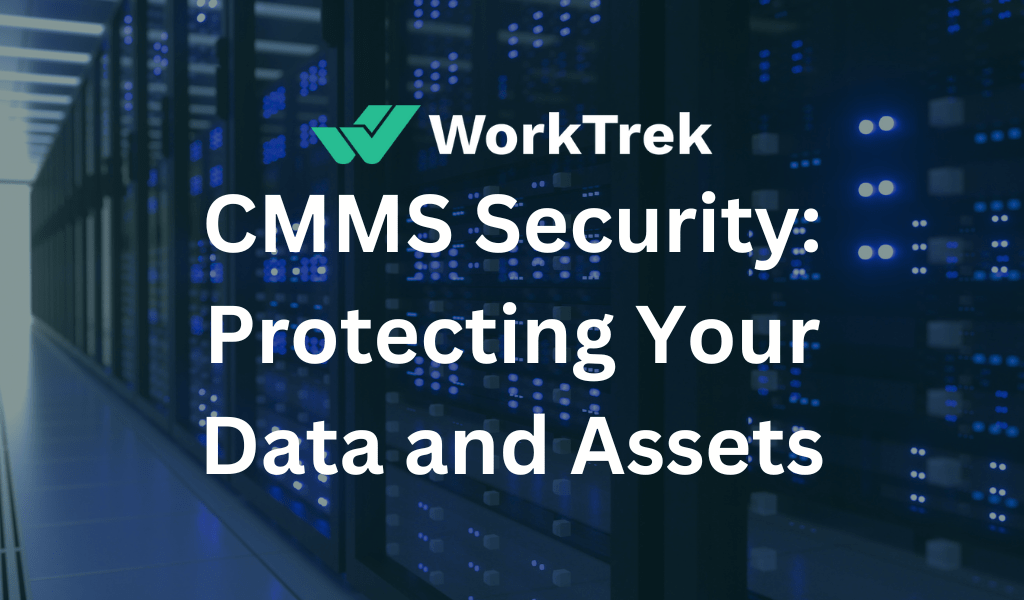Get a Free WorkTrek Demo
Let's show you how WorkTrek can help you optimize your maintenance operation.
Try for freeCMMS stands for Computerized Maintenance Management System, which is software used by organizations to manage and track maintenance operations, work orders, equipment, and assets. CMMS security refers to the measures and protocols in place to protect the data and the system itself in a CMMS from unauthorized access, data breaches, and cyber threats.
What is CMMS Security?
The security of a CMMS system depends largely on the completeness of the security measures and the consistency of their use by end users. When thinking about CMMS security overall, two areas come to mind: CMMS data security and user security. While cloud-based systems offer customers worry-free security, they are limited by the software provider’s maintenance schedule.

The Role of CMMS in Data Integrity and Backup
In the digital age, data integrity and protection are critical, especially in systems like CMMS that manage critical operational information. A great CMMS software ensures data accuracy through validation checks, real-time monitoring, and automated data logging, eliminating manual entry errors and ensuring that recorded data truly reflects field operations.
These backups also act as a safety net, ensuring data can be recovered in the event of an unforeseen system failure or cyber-attack. Combined with disaster recovery options, a CMMS not only ensures the security of data but also guarantees its availability even in adverse circumstances. In essence, a CMMS does more than just maintain, it serves as a beacon of data integrity and operational stability.
CMMS in Regulatory Compliance
Navigating complex industry regulations requires a tool that is both powerful and thorough. A CMMS has proven to be an indispensable tool and plays a vital role in ensuring that a company complies with applicable industry standards. By providing structured modules for mission planning, documentation, and real-time monitoring, a CMMS provides a systematic approach to meeting regulatory benchmarks. This not only ensures operational safety and efficiency but also complies with industry regulations.
Its comprehensive logging capabilities mean all maintenance, equipment inspections, and safety logs are recorded, dated, and easily accessible. This transparency and accessibility of data not only streamlines the audit process but also builds confidence for internal stakeholders and regulators in the organization’s commitment to compliance and operational excellence.

Learn About CMMS Capabilities
While you must take general security measures to protect your main system, every CMMS comes with many capabilities and pre-implemented security features that you can enable or disable at your convenience. The location of the CMMS can also have a significant impact on the level of security.
If you use an offline CMMS, an internal network is required. While this option is secure by limiting exposure to the open internet, it can be cumbersome to extend and update. With Cloud CMMS, on the other hand, you can access it from anywhere, and it can easily scale as your needs change. However, since the cloud is hosted online, you need additional security measures that your provider can provide.
Both types of CMMS software feature extensive settings menus that allow you to set up and deny specific management and access permissions, from backup to remote and mobile access capabilities.
Cloud-based CMMS Security
Customers find cloud-based CMMS attractive because of their simplicity and cost-saving benefits. The web-based CMMS is accessed through the provider’s servers, and all maintenance and upgrades are performed remotely. There is no need for dedicated system support or the installation of additional security software when using the platform. Cloud-based systems have lower upfront costs than on-premises systems.
Protecting corporate maintenance, inventory, and procurement systems and data from unauthorized access and transactions is critical to effective management, leadership, and control. Cloud-based CMMS systems use sophisticated data encryption protocols that are regularly updated as needed and maintained over time. CMMS software providers that offer web-based delivery go to great lengths to ensure the security of customer data and minimize downtime.

CMMS On-Premise Security
The biggest appeal of on-premises CMMS systems is that they provide maintenance managers with complete control and customizability over their data and systems. For example, on-premises system operators can plan system maintenance and upgrades on their own schedule rather than that of a cloud-based provider. While local systems may be less vulnerable to threats from global hackers, they are entirely dependent on a company’s choice of security software as well as the skills of internal IT staff, and the vigilance of system users.
CMMS User Security
Both cloud-based and on-premise CMMS platforms leverage user access security. Here is a list of relevant features offered by many maintenance management software providers:
- Access security at the database, facility, menu, function, window, and data element levels ensure full control of user access by design.
- Maintenance managers can set up role security profiles and assign users to roles, allowing users to predetermine access to some or all areas of the organization.
- Can create audit trails for visits, activities, and transactions
Use this and other accessibility features to ensure that specific users only see authorized details. This means that unauthorized access to any or all parts of the system is not allowed.

What CMMS Data Can Be Collected And Stored?
Best CMMS software applications store, collect, and efficiently automate maintenance management data from various areas within an organization.
Essentially, the CMMS data collected can be any data related to company equipment, assets, and other operational items such as manuals, maintenance instructions, and licenses.
The stored data can then be used for planned maintenance, inventory levels, facility security, purchasing, work orders, planning/scheduling, and staffing.
However, which data a business enters is obviously at the discretion of the business owner. You can choose to store your data only on larger, more expensive devices. And other owners may want to store information about equipment maintenance operations.
Regardless of the need, there are many benefits to collecting and storing CMMS data. CMMS Benefits include better organization, longer equipment life, and reduced operating costs (such as unplanned downtime).

Supercharge your maintenance with WorkTrek CMMS!
Book a WorkTrek demo to see how a CMMS can help your business.
Try for freeSome common types of data that can be collected and stored in a CMMS include:
Asset Information:
- Equipment details, including make, model, serial number, and location.
- Equipment specifications, manuals, and maintenance history.
- Warranty information and maintenance contracts.
Work Orders:
- Details of maintenance and repair work orders, including descriptions, priority, and scheduling.
- Labor and material costs associated with each work order.
- Completion status and dates.
Preventive Maintenance Schedules:
- Schedules for routine inspections, maintenance tasks, and equipment checks.
- Date of last maintenance and upcoming maintenance due dates.
Inventory and Spare Parts:
- Inventory levels of spare parts and materials.
- Reorder points, stock levels, and usage history.
- Supplier information and purchase orders.
Employee and Vendor Information:
- Information about maintenance personnel, their roles, and training records.
- Contact details for maintenance vendors and contractors.
Cost and Budget Data:
- Cost data related to maintenance activities, including labor, materials, and equipment.
- Budget allocation for maintenance operations.

The specific data collected and stored in a CMMS may vary depending on the organization’s needs and the capabilities of the CMMS software. This data is crucial for effective maintenance planning, resource allocation, and decision-making to ensure efficient and cost-effective asset management.
Benefits Of Collecting And Storing CMMS Data
Collecting and storing data in a CMMS offers benefits for industries involved in maintenance and asset management:
Improved Maintenance Planning and Scheduling:
Access to historical maintenance data helps maintenance teams plan and schedule maintenance tasks more efficiently. This reduces downtime and improves asset availability.
Enhanced Asset Management:
Detailed asset information, including maintenance history, allows for proactive asset management. This helps extend the life of assets and reduce the need for replacements.
Reduced Downtime:
With preventive maintenance data, organizations can identify and address potential issues before they cause unplanned downtime. This leads to higher productivity and cost savings.
Improved Collaboration:
A centralized system with shared data promotes collaboration and communication among maintenance teams, leading to more coordinated efforts.
Extended Equipment Life:
By tracking asset conditions and maintenance history, organizations can take steps to extend the useful life of equipment, reducing capital expenditure.
In summary, collecting and storing data in a CMMS provides organizations with a wealth of information that supports informed decision-making, cost control, asset management, safety, and overall operational efficiency. It is a valuable tool for organizations focused on effective maintenance and asset management.

What Your Software Vendor Should Be Doing To Protect Your Data?
When you’re using a Computerized Maintenance Management System (CMMS) provided by a software vendor, it’s crucial to ensure that the vendor is taking the necessary measures to protect your data. Here’s what your software vendor should be doing to safeguard your data in a CMMS:
Data Encryption:
Employ strong encryption methods to protect data both in transit and at rest. This includes encrypting data when it is transmitted over networks and storing data in an encrypted format on their servers.
Access Controls:
Implement robust access controls and user authentication mechanisms. Users should have unique logins and passwords, and the vendor should support multi-factor authentication for added security.
Security Updates:
Regularly update the CMMS software to address security vulnerabilities and issues. This includes promptly applying patches and fixes to protect against known threats.
Data Backup and Recovery:
You should have a secure and reliable data backup and recovery process in place. Regularly scheduled backups and a tested recovery process are essential to safeguard against data loss.
Vendor Support and Training:
The vendor should offer support and training to your organization to help you understand and implement security best practices within their CMMS.
User Training:
The vendor should offer training to your team regarding security best practices and how to use the CMMS securely.
It’s important to work with a reputable CMMS software vendor who takes data security seriously and has a strong commitment to protecting your data. Make sure to discuss security concerns with potential vendors and review their security measures before entering into an agreement.

How You Can Protect Data In CMMS?
Protecting data in a Computerized Maintenance Management System (CMMS) is critical to maintain the integrity and confidentiality of information. Here are some steps to safeguard CMMS data:
Access Control:
Implement strict user access controls. Ensure that only authorized personnel have access to the CMMS, and assign roles and permissions based on job responsibilities.
User Authentication:
Require strong, unique passwords for all users. Implement multi-factor authentication for an additional layer of security.
Data Encryption:
Encrypt data both in transit and at rest. This ensures that data is protected when transmitted over networks and stored in the CMMS database.
Software Updates:
Keep the CMMS software and all related systems up to date. Apply patches and updates promptly to address security vulnerabilities.
Training and Awareness:
Train employees on CMMS and users about security best practices. Create awareness about potential threats and the importance of data security.
By following these data protection measures, you can significantly enhance the security of your CMMS and safeguard sensitive maintenance and asset management data. Data security is an ongoing effort that requires continuous monitoring and adaptation to evolving threats.

Conclusion
In short, be careful not only of the software vendors you work with but also of the internal procedures that each team member follows to keep their data safe.
Overall, CMMS security is essential for maintaining operations, protecting data integrity, and ensuring regulatory compliance.









